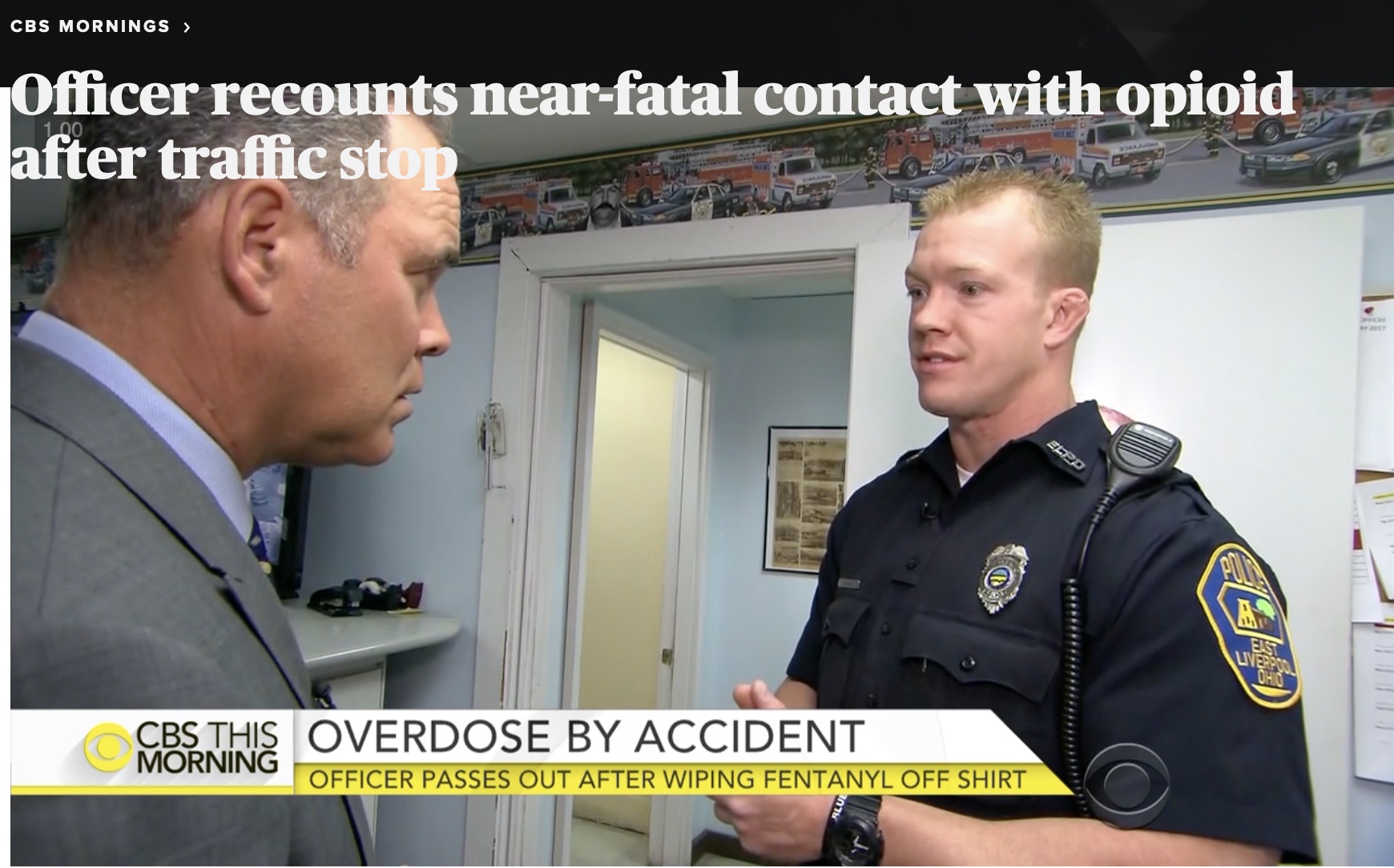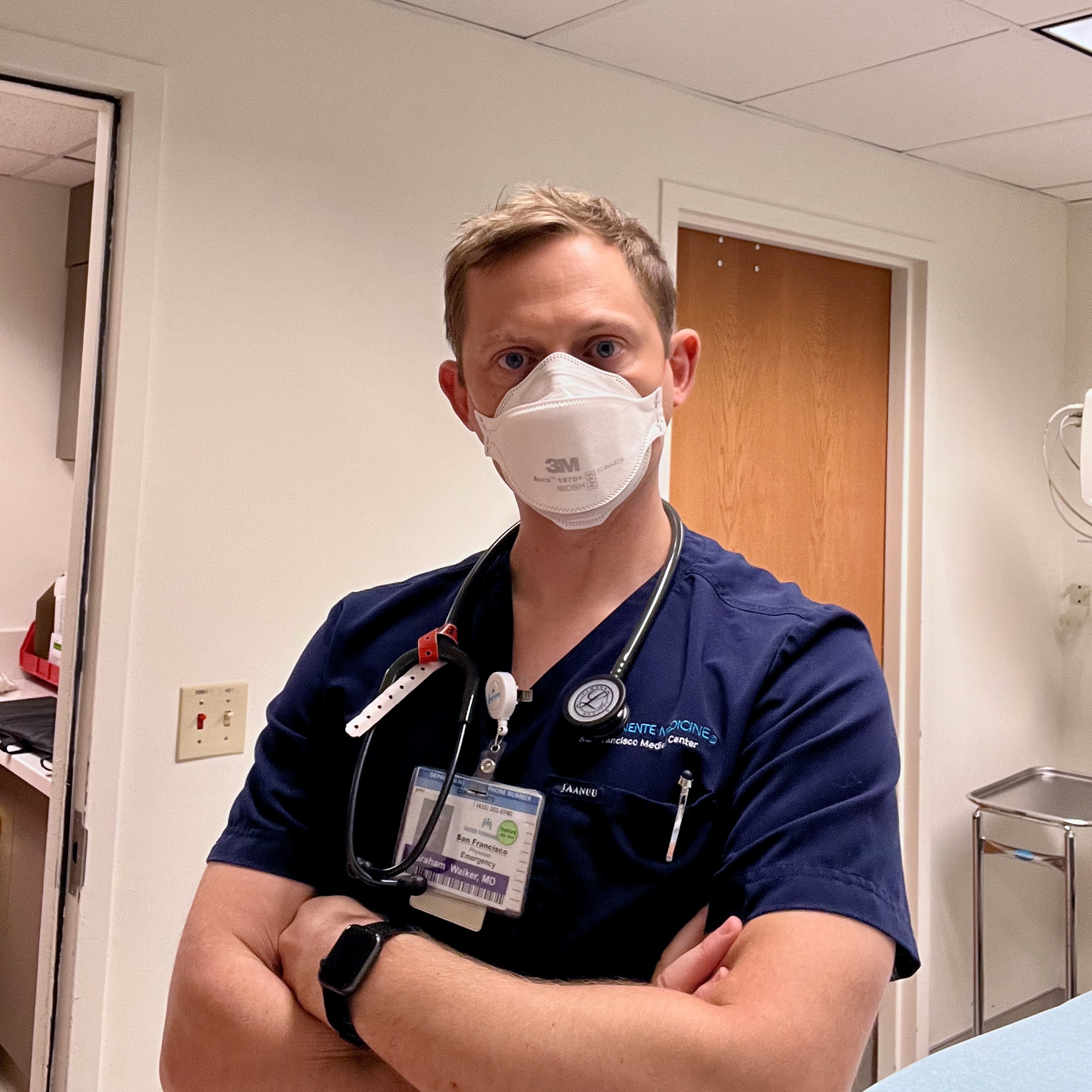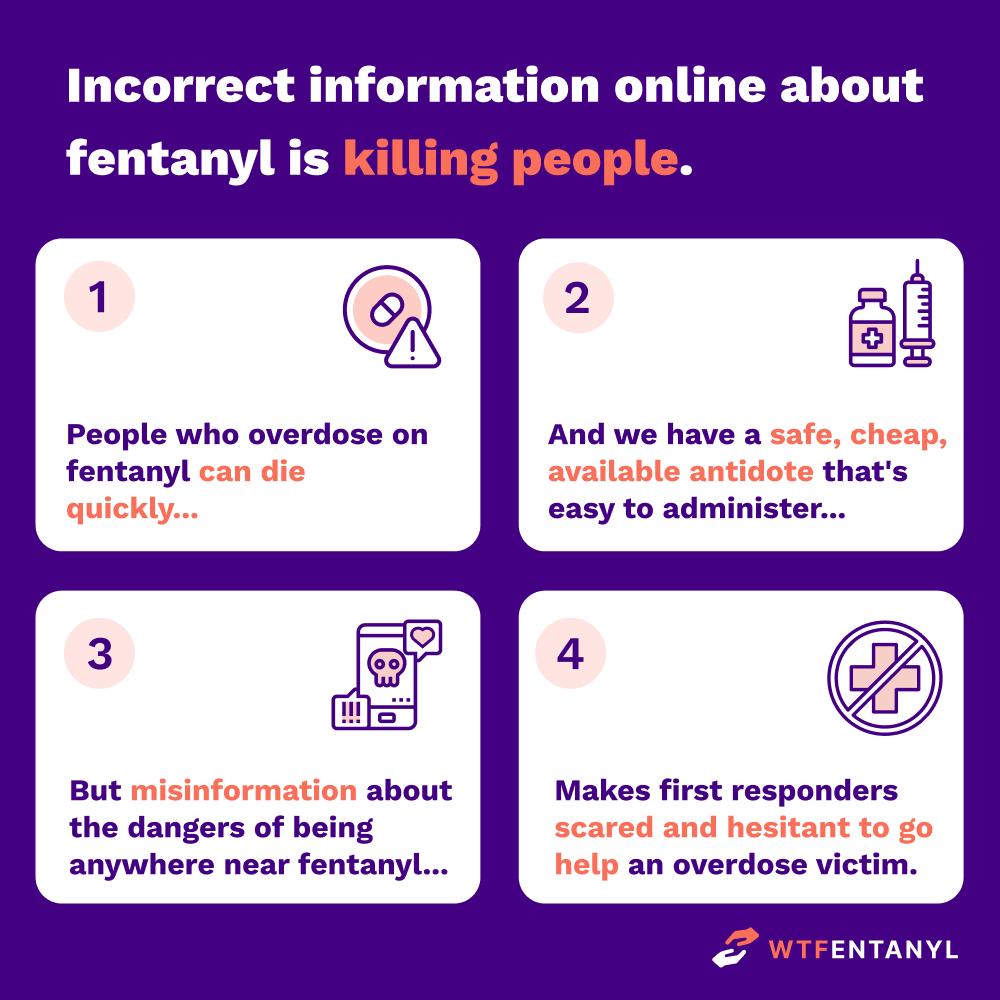The Basics About Fentanyl and Overdoses
What is Fentanyl?
Fentanyl is a synthetic opioid pain medicine, like morphine or oxycodone. It has been used for pain control in the medical field for over 60 years. In the United States, fentanyl has been illegally imported and sold to people with opioid use disorder (opioid addiction). Fentanyl is much stronger/concentrated than other medicines like morphine or oxycodone, and because of this, has a very high risk of overdose and death.
How do people die of fentanyl or other opioid overdoses?
Opioids can have several side effects, but the most dangerous is that they can slow and even stop your breathing. When people overdose on fentanyl, they can stop breathing entirely, and this can be rapidly fatal, with death occuring typically within minutes.
The key here are the symptoms of fentanyl/opioid overdose:
- Decreased or absent breathing
- Sleepiness, leading to unconsciousness (but not suddenly collapsing)
- Pintpoint/constricted pupils (the black part of the eye)
Thankfully, we have Naloxone. Naloxone is a highly effective medicine that can save lives when administered to patients experiencing fentanyl overdoses. Naloxone works by reversing the effects of opioids. It can be given as a shot in the muscle or a spray in the nose and can help someone start breathing again.
What misinformation are you referring to?
There are numerous reports of first responders — especially law enforcement officers — who have reported developing various symptoms when being exposed to various substances or powders while at work. These symptoms have been blamed on fentanyl, but they are not consistent with fentanyl toxicity.
Notice the symptoms are very different from fentanyl overdose:
- Dizziness and lightheadedness
- Hyperventilation
- Anxiety and Palpitations
- Collapsing without losing conscious
- Tingling and numbness in the body
These symptoms have occured after touching powders, or believing powders are in the air — and these powders are usually suspected to be fentanyl, even when chemical testing confirms that they are not fentanyl.
Why does this misinformation matter?
As stated above, naloxone — which is widely available and often carried by law enforcement officers, paramedics, and firefighters — can be absolutely life-saving in the face of an opioid overodose. In fact, according to the CDC there were over 100,000 fatal opioid overdoses from 2020-2021. So if these first responders are hesitant to approach an overdose victim due to fearing personal danger from being near fentanyl, they are much less likely to provide aid to these victims — and time is critical.
These symptoms have occured after touching powders, or believing powders are in the air — and these powders are usually suspected to be fentanyl, even when chemical testing confirms that they are not fentanyl.
What does the evidence say?
Don't necessarily believe some random website on the internet? No problem. You're welcome to take a look our About page to see who we are (physicians), and don't take our word for it, view this evidence from professional societies, poison control centers, the news, and even videos of fentanyl exposures without symptoms.
 The American College of Medical Toxicology (ACMT) and American Academy of Clinical Toxicology (AACT)
The American College of Medical Toxicology (ACMT) and American Academy of Clinical Toxicology (AACT)
"To date, we have not seen reports of emergency responders developing signs or symptoms consistent with opioid toxicity from incidental contact with opioids."
Read the position statement from the Journal of Medical Toxicology: The Journal of Emergency Medical Services
The Journal of Emergency Medical Services
"Standard nitrile medical gloves and duty uniforms provide adequate dermal protection."
Read Fentanyl Facts and Fiction: A Safety Guide for First Responders: Emergency Medicine News: Myths in Emergency Medicine
Emergency Medicine News: Myths in Emergency Medicine
"All those reports you've seen in the news? Not a single one has been verified by an actual toxicologist or physician."
Read First Responders Worried about Fentanyl OD? Minimize Fear by Quashing that Myth  New England Poison Control Center
New England Poison Control Center
"The risk of significant opioid exposure is minimal for first responders who encounter fentanyl, carfentanil or other fentanyl analogs in the field."
Read Fentanyl and Carfentanil Exposures in First Responders from New England Poison Control Centers  Reuters News Fact Check
Reuters News Fact Check
"Overdose of fentanyl just by being in its presence is not possible."
Read Reuters Fact Check  Video: Man puts fentanyl powder in his palm, nothing happens
Video: Man puts fentanyl powder in his palm, nothing happens
"I have fentanyl on my skin. I am experiencing no signs of toxicity, and no overdose symptoms."
Watch Chad Sobora on Facebook Video  Exposure to a Large Volume of Liquid Fentanyl on a Compromised Skin Barrier with No Resultant Effect
Exposure to a Large Volume of Liquid Fentanyl on a Compromised Skin Barrier with No Resultant Effect
"The patient underwent appropriate decontamination and underwent a brief medical assessment with no clinical effects of opioid exposure observed."
Read the Article on Pubmed  Collection of Debunked Fentanyl Exposure Stories
Collection of Debunked Fentanyl Exposure Stories
We have collected these stories and followed up on them.
Read them here on our site.Frequently Asked Questions
- Standard nitrile medical gloves and duty uniforms provide adequate dermal protection. If suspected fentanyl powder is found on skin or clothing, the dry powder should be brushed away and then the area should be cleansed with soap and water. Contact with intact skin or clothing isn't considered a hazardous exposure.
- Respiratory protection isn't required for routine operations. In the extremely unlikely event that it's suspected that drug droplets or particles are suspended in the air, standard disposable N95 masks will provide sufficient respiratory protection.
- Naloxone should be readily available, and all responders should be trained in its use and administration. Naloxone should only be administered to individuals who present with objective signs of opioid toxicity such as altered mental status with hypoventilation, unconsciousness and respiratory depression. Naloxone isn't indicated for individuals who experience vague sub-clinical symptoms like nausea, vomiting, fatigue, dyspnea, dizziness and anxiety.3 In the unlikely event that an exposure to fentanyl occurs, in the absence of extended hypoxia, there's no long-term risk to responders.
- Persaud and Jennings found in 2019 that of 247 first responders (police, fire, EMS), most believed that touching fentanyl was dangerous.
- Winograd conducted 8 law enforcement officer (LEO) trainings in 2019 in Eastern Missouri and found that almost 80% of 200 people interviewed believed"I can overdose from touching fentanyl."
- Attaway and Smiley-McDonald interviewed 23 LEOs from 5 different agencies and found that almost all believed that dermal exposure to fentanyl"is a signficant occupational hazard with possibly fatal outcomes, despite no confirmed cases of an officer experiencing an overdose after encountering fentanyl on the job."
- del Ponzo and colleagues interviewed 129 LEOs across Indiana and found that only 20% believed that"First responders who encounter fentanyl are at great risk of overdose by touching it or inhaling it."
- Attaway and Smiley-McDonald interviewed 23 law enforcement officers (LEOs) from 5 different agencies and found that almost all believed that dermal exposure to fentanyl"is a signficant occupational hazard with possibly fatal outcomes, despite no confirmed cases of an officer experiencing an overdose after encountering fentanyl on the job."
- Stolbach et al. also report that this phenomenon may have even started in 2016, especically driven by DEA warnings about touching fentanyl. Their paper shows dramatic growth in media reports starting in Q2 of 2017.
- Beletsky et al. similarly show major jumps in media reporting as well as Facebook engagements, as well as much lower rates of engagements with corrected misinformation on Facebook.
- Stolbach et al. also report that this phenomenon may have even started in 2016, especically driven by DEA warnings about touching fentanyl. Their paper shows dramatic growth in media reports starting in Q2 of 2017.
Similarly, take a look at our evidence section; we provide both a scientific paper reporting a massive skin contamination with fentanyl (with broken skin!) and no side effects as well as a video of a man placing a large quantity of fentanyl in the palm of his hand and having no symptoms.
Finally, none of the people who are using fentanyl are experiencing the symptoms that the officers report, and if anyone is around fentanyl a lot, it is them. They are not using gloves. They are not wearing masks despite being in close contact with fentanyl. So why aren't they overdosing from simply being in casual contact with fentanyl?
For Journalists
Please contact us if you are running a story that purports to have a fentanyl exposure!
Contact us on social media or email us directly; we are more than happy to give on-camera interviews, written responses to questions, or provide any other information we can to try to stop this misinformation from spreading further.
Please do not implicitly trust police spokespeople.
There are countless examples of spokespeople/media relations representatives for police departments and police unions who go on the record reporting fentanyl involvement and then later retract their statements. This is incredibly damaging and further spreads this misinformation.
Where did this all of this misinformation come from?
In 2017, police officer Chris Green of East Liverpool, Ohio reported brushing a powder off his shirt after arresting suspect Justin Buckle. Officer Green said he then felt unwell and was taken to the hospital. The story was initially published in the local news but then went on to gain national attention, despite multiple problems with the story that were never reported:

- First and most importantly, it is not possible to overdose — or even experience any effects — from briefly brushing fentanyl off of your clothing with your bare hands. Powder or liquid fentanyl does not absorb through the skin.
- Officer Green's is inconsistent and changes during different media interviews. The the formal police report that he filed states that he felt states that he was feeling short of breath; fentanyl does not make you feel short of breath — in fact we will often use fentanyl or other opioid medicines as a treatment for shortness of breath in medical care.
- Officer Green reports that he has ongoing medical problems to the media and in the police report as well. He reported feeling"aches and the pains" and"the total loss of control of my body." Again, fentanyl is a treatment for pain. Touching fentanyl would certainly not make you feel pain.
- Suspect Justin Buckle was sentenced to 6.5 years in prison for a variety of charges including trafficking in cocaine and heroin — but not trafficking of fentanyl.
Want more examples of this hysteria? Please see our "Debunked Cases" below.
About Us
We are a team of emergency physicians, toxicologists, and addiction medicine specialists who want to set the record straight about fentanyl exposures. We are extremely experienced with fentanyl — both caring for patients with overdoses as well as using it medically to treat pain.

Ryan Feldman, PharmD, BCPS, DABAT
Emergency Medicine Pharmacist & Clinical Toxicologist
Ryan Marino, MD
Emergency Physician, Medical Toxicologist, & Addiction Medicine Physician
Khudhur Mohammed, MD
Junior Doctor & Designer
Daniel Runde, MD
Emergency Physician
Andrew Stolbach, MD
Emergency Physician & Medical Toxicologist
Josh Trebach, MD
Emergency Physician & Medical Toxicologist
Graham Walker, MD
Emergency Physician & Web Developer/CreatorContact Us
Feel free to message us directly on Twitter or email us.
Email:
wtf@wtfentanyl.com
Hours:
We're emergency doctors. We're 24/7.
Debunked Cases
Below you'll find a list of cases reported in the media of casual fentanyl overdoses that were later debunked.
- A police sergeant was treated for a"fentanyl-laced flier " in 2018. Lab tests found no fentanyl on the fliers.
- In 2022 a woman stated that she picked up a dollar bill laced with fentanyl. Her testing came back negative for any drugs in her system, and she was not given any naloxone (Narcan) to reverse the effects of any opiates as well.
- In August of 2021, the San Diego Police Dept released footage of Deputy David Faiivae allegedly overdosing on fentanyl; this was immediately met by criticism from medical experts as the video footage is not consistent with someone experiencing effects or overdose from fentanyl. Two months later, the SDPD apologized for the video hurting the department's credibility (and never released any reports confirming the deputy's toxicology reports, although lab reports did find that the substance in the video was fentanyl).

